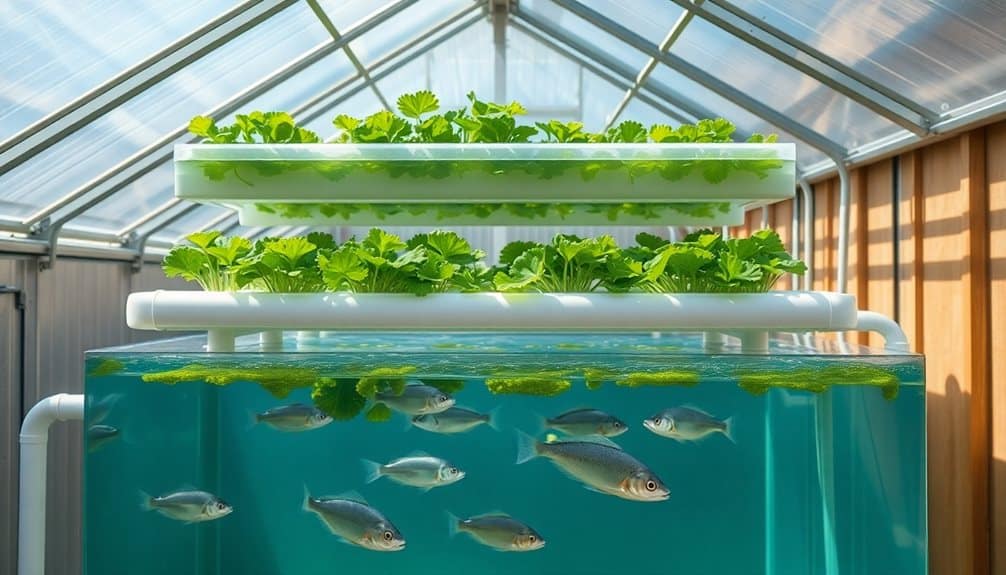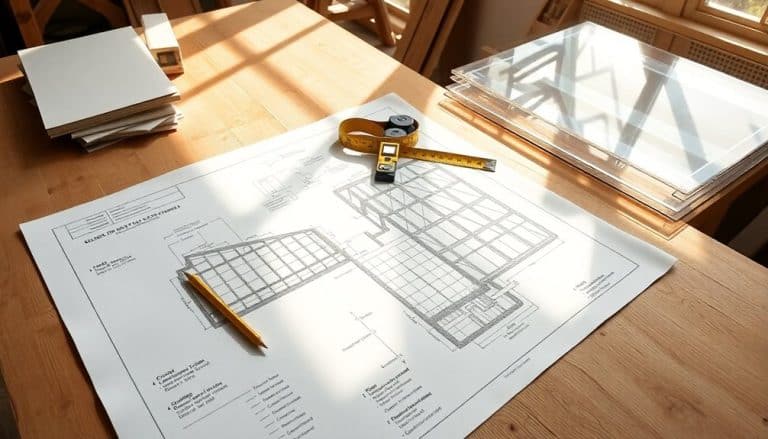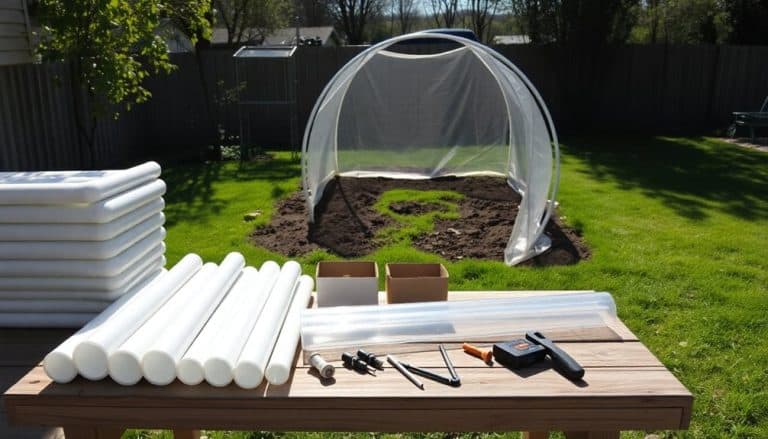This website contains affiliate links. Some products are gifted by the brand to test. As an Amazon Associate, I earn from qualifying purchases. The content on this website was created with the help of AI.
To build a DIY greenhouse aquaponics system, you’ll need to start with proper layout planning and component selection. Position your fish tank (minimum 100 gallons) on the north side, then elevate your growing beds 12-18 inches above it using food-grade IBC totes. Install a 1000 GPH submersible pump, biofilter, and food-grade PVC piping for water circulation. Set up digital sensors for pH, temperature, and dissolved oxygen monitoring, along with automated dosing systems. Maintain 3-foot clearance around tanks and guarantee proper support structure for wet media weight (80-100 lbs per cubic foot). The following steps will transform your greenhouse into a sustainable food production system.
Key Takeaways
- Position fish tanks on the north side with 3-foot maintenance clearance and install grow beds elevated 12-18 inches above tanks.
- Install 1000 GPH submersible pump, bio-filter, and mechanical filter with food-grade PVC piping for efficient water circulation.
- Build raised grow beds using food-safe materials, maintaining 12-inch depth and 1-degree slope for proper drainage.
- Set up digital sensors for pH, temperature, and oxygen monitoring, with automated dosing systems for pH regulation.
- Maintain NPK ratios and pH levels between 6.0-7.0, using phosphoric acid and potassium hydroxide for adjustments.
Planning Your Aquaponics Layout

Success in greenhouse aquaponics begins with a well-planned layout that maximizes space efficiency and system functionality. You’ll need to allocate space for three primary components: fish tanks, filtration units, and growing beds. Start by measuring your greenhouse’s dimensions and creating a scaled diagram that accounts for walkways and maintenance access.
Position your fish tanks on the north side of the greenhouse to minimize direct sunlight exposure and maintain stable water temperatures. Allow a minimum of 3 feet of clearance around tanks for easy maintenance. Your mechanical and biological filtration units should be situated between the fish tanks and growing beds, utilizing gravity flow whenever possible to reduce energy consumption.
Design your growing beds in modular sections, considering both deep media beds and NFT (Nutrient Film Technique) channels. You’ll want to maintain a fish-to-plant ratio of 1:4 for ideal nutrient balance. Install your plumbing infrastructure along the greenhouse’s support structures, incorporating isolation valves at key points for system maintenance. Don’t forget to designate space for monitoring equipment, backup power systems, and water storage tanks to guarantee operational resilience.
Essential Components and Materials
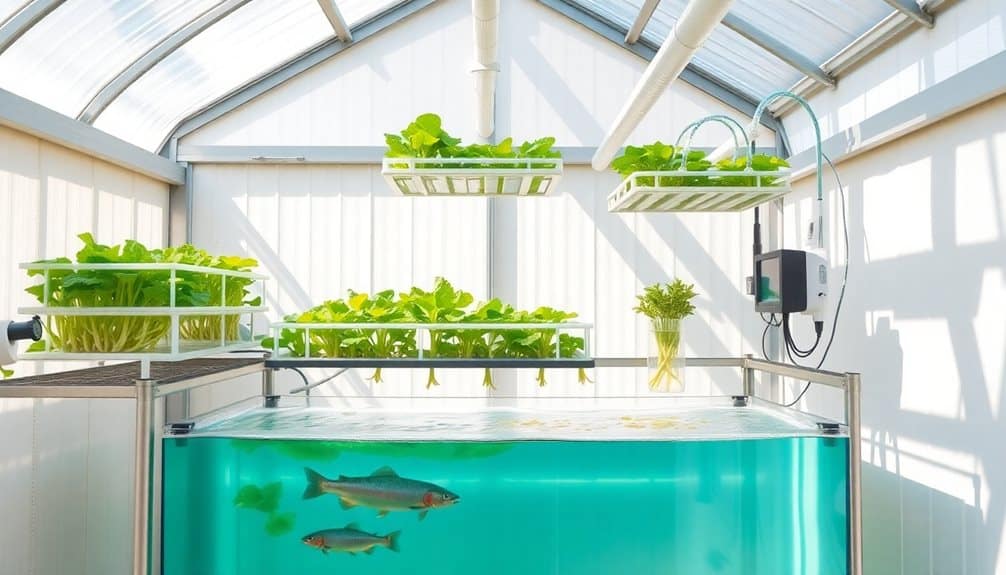
Building your aquaponics system requires specific materials and components that work together to create a sustainable ecosystem. You’ll need a fish tank (minimum 100 gallons), grow beds (preferably food-grade IBC totes), and a solid support structure made from pressure-treated lumber or metal framing. For water circulation, install a submersible pump (minimum 1000 GPH), bio-filter, mechanical filter, and food-grade PVC piping.
Your system’s plumbing components should include ball valves, uniseals, standpipes, and bell siphons for each grow bed. You’ll also need air pumps and stone diffusers to maintain proper oxygen levels for both fish and plant roots. For monitoring, acquire a pH meter, thermometer, dissolved oxygen meter, and TDS (Total Dissolved Solids) tester.
Essential growing media includes expanded clay pellets or river rock for the grow beds, while you’ll need fish feed, water conditioner, and bacterial starter culture for the aquaculture component. Don’t forget backup systems: an emergency generator, extra pump, and UPS battery backup. For greenhouse integration, you’ll need polycarbonate panels, aluminum framing, and automated ventilation components. Consider installing adjustable roof vents to maintain optimal temperature control and prevent overheating during peak growing seasons.
Tank Setup and Plumbing
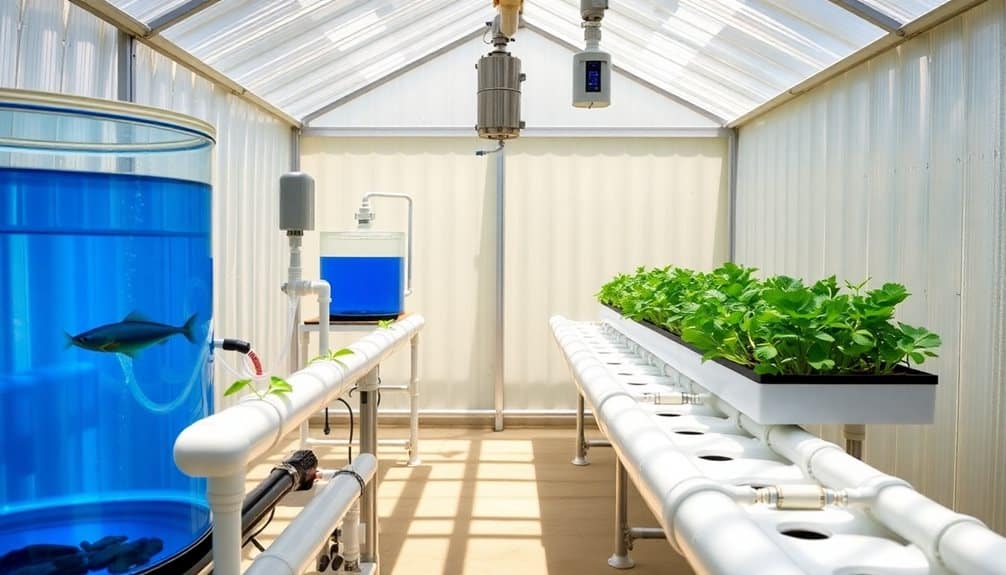
A well-planned tank setup forms the foundation of your aquaponics system’s plumbing network. You’ll need to position your fish tank at the lowest point of your system, with grow beds elevated 12-18 inches above it. Install a solids filter between the fish tank and grow beds to prevent clogging and maintain water quality.
Connect your tanks using 1-inch PVC pipes for the main flow and ¾-inch pipes for branch lines. Install ball valves at key junction points to control water flow and facilitate maintenance. You’ll need to create two primary plumbing circuits: the delivery system that pumps water up to the grow beds, and the return system that channels water back to the fish tank through gravity.
Set up your submersible pump in the fish tank’s deepest section, ensuring it’s powerful enough to circulate your system’s entire water volume 4-6 times daily. Install standpipes in each grow bed to maintain proper water levels and prevent overflow. Add aeration points using air stones connected to an air pump, placing them strategically in both the fish tank and grow beds to maintain ideal dissolved oxygen levels.
Growing Bed Construction

Proper construction of growing beds serves as the cornerstone of your aquaponics system‘s plant production. You’ll need to build raised beds that can support the weight of your growing medium, water, and mature plants while maintaining proper drainage and even water distribution.
Select food-safe materials for your beds, preferably HDPE liner or food-grade IBC totes cut to size. You’ll want to maintain a depth of 12 inches for ideal root development and adequate filtration. Install bulkhead fittings at precise intervals to guarantee uniform water flow.
Key considerations for your growing bed construction:
- Calculate load-bearing requirements – wet media typically weighs 80-100 lbs per cubic foot
- Install auto-siphons or standpipes to maintain proper water levels
- Position beds at a 1-degree slope for efficient drainage
- Use UV-resistant materials to prevent degradation
- Include inspection ports for monitoring root health and cleaning
When installing the beds, verify they’re level and properly supported by your greenhouse structure. Add corner bracing for additional stability, and test the plumbing connections before adding your growing medium. Your beds should sit 30-36 inches high for comfortable access and maintenance.
System Monitoring and Controls
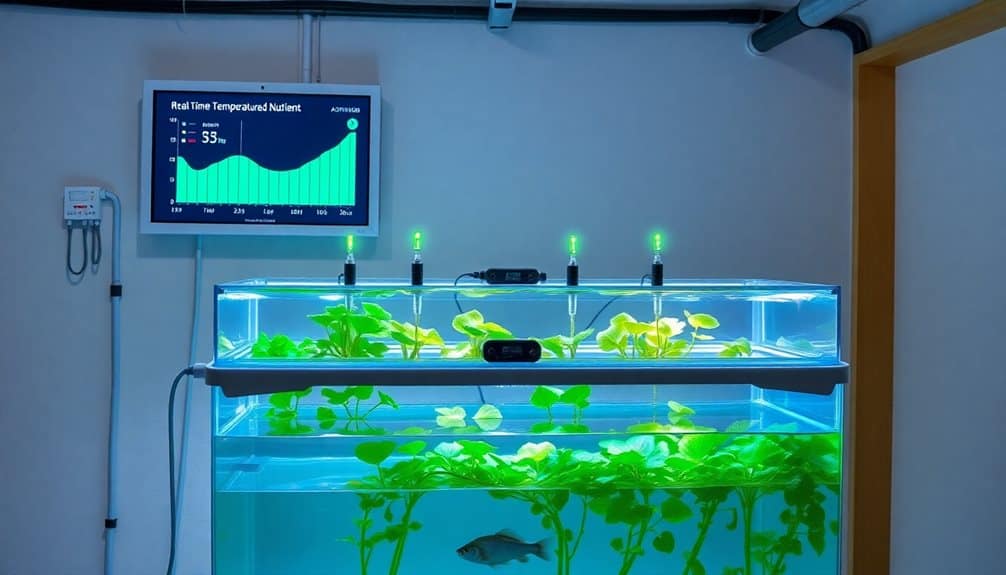
Maintaining control over your aquaponics system requires robust monitoring equipment and automated solutions that track critical parameters 24/7. You’ll need to install digital pH sensors, temperature probes, dissolved oxygen meters, and water level indicators connected to a central control hub. Modern IoT-enabled controllers let you monitor these metrics remotely through smartphone apps.
Set up automated dosing systems to regulate pH levels using food-grade buffers, and install float switches that trigger backup water supplies if levels drop too low. Your temperature control system should include thermostatic heaters, cooling fans, and shade cloths managed by programmable controllers. Configure alarm thresholds for each parameter to receive instant notifications if readings fall outside acceptable ranges.
Install backup power systems with automatic transfer switches to maintain critical functions during outages. Use data logging features to track long-term trends and system performance. Mount water flow meters on your pump lines to monitor circulation rates, and install electrical consumption monitors to optimize energy usage. Regular calibration of your sensors guarantees accurate readings, while redundant monitoring systems provide failsafe protection for your fish and plants.
Fish Selection and Care

With your monitoring systems in place, selecting the right fish species becomes your next key consideration. You’ll want to choose fish that thrive in your climate zone and align with your system’s capacity. Tilapia remains the most popular choice for beginners due to their hardiness and rapid growth rate, though other species can work well too.
Consider these critical factors when selecting and caring for your aquaponics fish:
- Water temperature requirements (tilapia need 70-85°F, while trout prefer 50-65°F)
- Stocking density (maintain 1 pound of fish per 5-10 gallons of water)
- Feed conversion ratio (FCR) and growth rates
- Disease resistance and overall hardiness
- Local regulations and availability
You’ll need to establish a consistent feeding schedule and monitor your fish’s behavior daily. Feed them 2-3 times daily, providing only what they’ll consume within 5 minutes. Remove any uneaten food to prevent water quality issues. Regular health checks are essential – look for signs of stress, unusual swimming patterns, or physical abnormalities. Maintain quarantine protocols when introducing new fish to prevent disease transmission.
Plant Nutrient Management
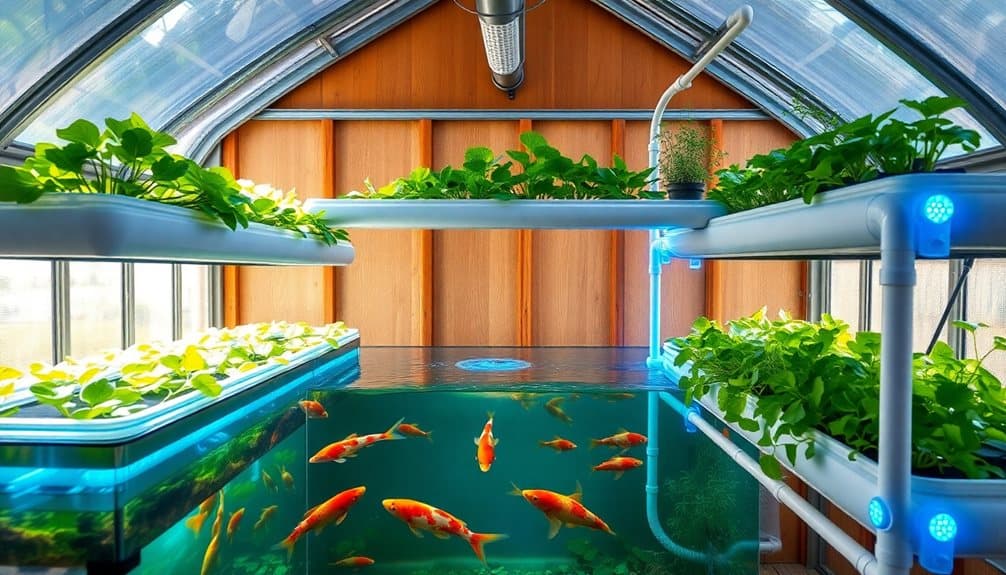
Success in aquaponics hinges on precise nutrient balance between fish waste and plant requirements. You’ll need to monitor key nutrients including nitrogen, phosphorus, and potassium (NPK), along with micronutrients like iron, calcium, and magnesium. Test water parameters weekly using reliable aquaculture test kits to maintain ideal nutrient levels.
To address nutrient deficiencies, you’ll need to implement targeted solutions. Add iron chelate supplements when plants show yellowing leaves, and maintain calcium levels by adding food-grade calcium hydroxide. If you notice stunted growth, supplement with seaweed extract or mineral-based additives specifically designed for aquaponics systems.
Keep pH levels between 6.0-7.0 to maximize nutrient availability for plants. You can adjust pH using phosphoric acid to lower it or potassium hydroxide to raise it. Don’t forget to check electrical conductivity (EC) levels daily – aim for 1.5-2.5 mS/cm depending on your crop selection. Install automated dosing systems to maintain consistent nutrient levels, and document all measurements in a digital log to track trends and enhance your system’s performance over time.
Frequently Asked Questions
How Much Electricity Does a DIY Aquaponics System Consume Monthly?
Your DIY aquaponics system’s electricity consumption typically ranges from 150-800 kWh monthly, depending on your setup size. You’ll need power for water pumps (40-100W), air pumps (5-20W), and grow lights (200-600W). If you’re running a small home system with basic components, expect around 200 kWh monthly, while medium systems with additional lighting and heating can reach 500 kWh.
Can I Move My Aquaponics System After It’s Fully Operational?
While you can move an operational aquaponics system, you’ll need careful planning. First, transfer fish to temporary tanks with original system water. Next, drain 50% of the grow beds while preserving the bacterial colonies in your media. Disassemble components systematically, labeling all connections. At the new location, reassemble quickly, refill with the saved water, and reintroduce fish within 24 hours to minimize stress.
What Permits Do I Need for a Backyard Aquaponics Greenhouse?
Ah, you thought escaping bureaucracy by growing food in your backyard was easy? You’ll need to check with your local zoning department for building permits, HOA restrictions, and setback requirements for your greenhouse structure. Contact your state’s agriculture department about aquaculture licenses, fish stocking permits, and water usage regulations. Don’t forget environmental impact assessments if you’re in an ecologically sensitive area.
How Does Extreme Weather Affect Greenhouse Aquaponics Systems?
Extreme weather can greatly impact your greenhouse aquaponics system. High temperatures can reduce oxygen levels in water and stress fish, while freezing conditions can damage pipes and kill plants. You’ll need to install thermal barriers, shade cloth, or cooling fans for heat management. During cold snaps, use heaters and insulation to maintain water temperature. Strong winds can damage greenhouse structures, so reinforce supports and consider installing windbreaks.
Are Aquaponics-Grown Vegetables and Fish Covered by Home Insurance Policies?
Only 12% of standard home insurance policies explicitly cover aquaponics systems. You’ll need to contact your insurance provider to verify if your policy covers aquaponics-grown produce and fish as personal property. Consider adding a specific rider or endorsement to your policy for extensive coverage. If you’re selling your produce, you’ll likely need additional commercial insurance to protect against crop loss and liability claims.

